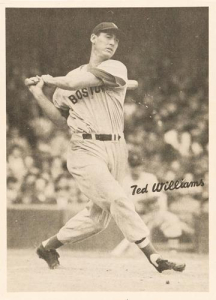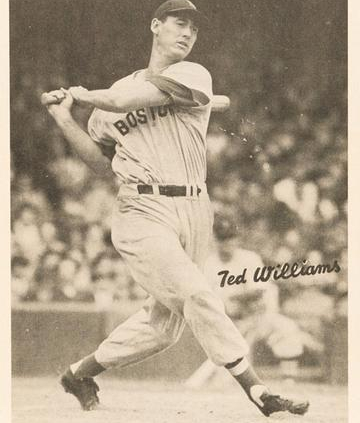May 18, 1949: Ted Williams hits his first game-winning homer of the season
 It was a Wednesday afternoon in May. The Chicago White Sox were in Boston. The season was young.
It was a Wednesday afternoon in May. The Chicago White Sox were in Boston. The season was young.
Chicago (14-13) was in fourth place. The Red Sox were 11-13, in seventh place, but only five games behind the league-leading Yankees. The season was full of possibilities for both teams. The Red Sox had lost the 1948 pennant in a one-game tiebreaker with the Cleveland Indians. The White Sox had suffered through a dismal 1948 season, finishing in last place, 44½ games behind. Perhaps unsurprisingly, they had a new manager in 1949, Jack Onslow. Red Sox manager Joe McCarthy was back for his second season.
Fenway Park had been something of a jinx for the White Sox in 1948. They had won only once in 11 games there.1
Starting for the Red Sox was Ellis Kinder, a 34-year-old right-hander in his fourth major-league season.
The White Sox started right-hander Marino Pieretti, a native of Lucca, Italy, who had grown up in San Francisco.
Kinder retired the first three White Sox in the first. Pieretti was tagged for three runs in the bottom of the inning.
Center fielder Dom DiMaggio led off for Boston with a drive that “bounced past [center fielder] Gerry Scala for a triple.”2 Third baseman Johnny Pesky grounded out to first base; DiMaggio held at third. Ted Williams singled to right field and it was 1-0.
Pieretti struck out shortstop Vern Stephens for the second out, but second baseman Bobby Doerr homered into the net above the left-field wall. Right fielder Al Zarilla walked but was caught stealing second base. Boston had a 3-0 lead.
Kinder walked two in the top of the second. They were both stranded. Pieretti retired the Red Sox in order in the bottom of the inning.
In the top of the third, first baseman Gordon Goldsberry and shortstop Luke Appling hit two-out singles for Chicago, but no runs scored.
Ted Williams hit a two-run homer with one out in the bottom of the third. It was “a tremendous belt about 10 rows up in the right field stands – a lordly poke with plenty of carry.”3 The homer was estimated by the Chicago Tribune at about 390 feet, hit “into the right field wing.”4 DiMaggio had walked ahead of Williams’s blast. Boston’s advantage was 5-0.
Onslow replaced Pieretti at this point with a left-hander, 37-year-old veteran Clyde Shoun, who had been purchased from the Boston Braves a week earlier, on May 11. Stephens doubled but was erased when Doerr hit into a fielder’s choice. After Zarilla walked, first baseman Billy Hitchcock grounded out, Shoun to Goldsberry.
Right fielder Billy Bowers got Chicago’s only hit of the fourth, a single to right field. The Red Sox improved their lead to 6-0 in the bottom of the inning. DiMaggio drew a two-out walk and Pesky drove him in with a double to right-center.
After Kinder got the first two outs in the top of the fifth, Goldsberry singled and Appling drew a base on balls. Left fielder Gus Zernial cut the lead in half with a three-run homer to left – a drive that the Boston Herald said was still climbing when it hit high in the net.5 The White Sox weren’t finished with hitting: A double and a single followed hard on Zernial’s heels, but Kinder struck out the third baseman, Floyd Baker, to end the inning with Boston’s lead at 6-3.
The Red Sox kicked off their half of the fifth with back-to-back singles, but nothing came of the two hits.
Birdie Tebbetts led off Boston’s sixth – Max Surkont was pitching for the White Sox now, Shoun having been lifted for a pinch-hitter – with a single to left field. Kinder’s sacrifice moved Tebbetts to second. DiMaggio walked, and then Pesky doubled, driving in Tebbetts to push the lead to 7-3. Perhaps wisely, Ted Williams was given an intentional walk. Stephens stuck out and Doerr popped out to Appling at short.
Neither team put a runner on base in the seventh.
Catcher Don Wheeler singled for the White Sox in the eighth. Pesky walked for the Red Sox. No others reached base.
In the top of the ninth, the White Sox scored once more – but only once. Center fielder Scala struck out. Goldsberry singled, his third hit of the game. Appling grounded out, with Goldsberry taking second base. Zernial dropped a double that traveled more than 400 feet to near the flagpole in center field by the Red Sox bullpen, driving in Goldsberry. Zernial had driven in all four of Chicago’s runs. But second baseman Cass Michaels lined out to end the game.
When sportswriters looked to Zernial for remarks after the game, he was somewhat curt: “We didn’t win the ball game, did we?”6 Tebbetts talked about pitching to Zernial: “Kinder had him struck out in the fifth, and I dropped the foul tip. Then he got an inside pitch and hit a three-run homer. Kinder got the ball a little more over the middle of the plate in the ninth and he hit that long double to center for another run.”7
It was a 7-4 complete-game win for Kinder, improving his season record to 3-1. He’d struck out nine, walked three, and given up more hits (11) than the Red Sox had as a team (10), but still come out on top. Kinder finished the 1949 season with a record of 23-6, the best winning percentage in the major leagues. His six shutouts also led both leagues, tied for the honor with Virgil Trucks.
Williams had the game-winning base hit, his home run in the third inning. It was the 44th game-winning homer of Williams’s career, but the first in 1949.8 He ultimately hit 110 game-winning homers.9
The 1949 season was a very good one for “The Kid.” He led the league in home runs with 43, He drove in 159 runs, tied with teammate Vern Stephens for the most in the majors. Had he made just one less out, or had one more hit, he would have won the American League batting title, too, and thus the Triple Crown.10 He did win the “on-base percentage Triple Crown” – his .490 on-base percentage for the year led the majors and was 61 points ahead of second-place finisher Luke Appling.11
Acknowledgments
This article was fact-checked by Gary Belleville and copy-edited by Len Levin.
Sources
In addition to the sources cited in the Notes, the author consulted Baseball-Reference.com and Retrosheet.org.
https://www.baseball-reference.com/boxes/BOS/BOS194905180.shtml
https://www.retrosheet.org/boxesetc/1949/B05180BOS1949.htm
Notes
1 The one win was on June 12.
2 Irving Vaughan, “White Sox Lose, 7-4,” Chicago Tribune, May 19, 1949: A1. The spelling of Scala’s first name was Vaughan’s. Scala’s first name was Gerard. Clif Keane’s Boston Globe account said that Jerry Scala had “misplayed” the ball. Clif Keane, “Williams, Doerr Hit Home Runs; Kinder Wins 3rd,” Boston Globe, May 19, 1949: 1.
3 Will Cloney, “Red Sox Triumph, 7-4,” Boston Herald, May 19, 1949: 37.
4 Vaughan. The “right-field grandstand,” wrote Keane.
5 Cloney.
6 Keane.
7 Keane.
8 A “game-winning home run” is defined here as a home run that provides a game’s final margin of victory, giving the winning team at least one more run than the opposing team scored. For example, if a two-run homer increased a team’s lead from 2-1 to 4-1, and it went on to win 4-3, it qualifies as a game-winning home run. (This is different from the definition of “game-winning RBI” in baseball’s official statistics from 1980 through 1988, which counted as “game-winning” the RBI that provided a winning team the lead that it never relinquished.)
9 For a look at each of Williams’s game-deciding home runs, see Bill Nowlin, “The Kid” Blasts A Winner – Ted Williams’ Game-Deciding Home Runs (South Orange, New Jersey: Summer Game Books, 2022).
10 George Kell finished 1949 with a batting average of .3429119 to Williams’s .3427562.
11 See Bill Nowlin, “The OBP Triple Crown,” Baseball Research Journal, Vol. 37, 2008: 105-106.
Additional Stats
Boston Red Sox 7
Chicago White Sox 4
Fenway Park
Boston, MA
Box Score + PBP:
Corrections? Additions?
If you can help us improve this game story, contact us.


